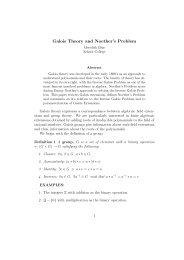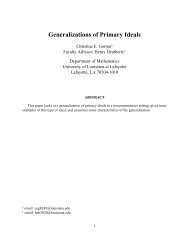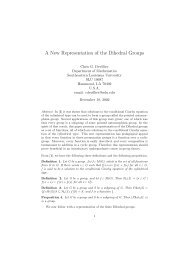Divisibility of the Determinant of a Class of Matrices ... - MAA Sections
Divisibility of the Determinant of a Class of Matrices ... - MAA Sections
Divisibility of the Determinant of a Class of Matrices ... - MAA Sections
You also want an ePaper? Increase the reach of your titles
YUMPU automatically turns print PDFs into web optimized ePapers that Google loves.
dimension. First, we look at examples involving 2-by-2 matrices to see if this<br />
case holds: if we are given two two-digit integers (say, x = a 1 a 2 and y = b 1 b 2 )<br />
and if <strong>the</strong>se integers are divisible by a given integer k, is it true that k also<br />
<br />
a1 a<br />
divides <strong>the</strong> determinant <strong>of</strong> <strong>the</strong> matrix<br />
2<br />
b 1 b 2<br />
?<br />
<br />
We investigate this case and see if it extends to higher dimensions, that<br />
is to <strong>the</strong> 3-by-3 case, to <strong>the</strong> 4-by-4 case, and in general, to <strong>the</strong> n-by-n case.<br />
Although <strong>the</strong> original problem gave a very specific matrix, we solve a generalization<br />
<strong>of</strong> this problem and also look at o<strong>the</strong>r problems regarding <strong>the</strong><br />
determinant <strong>of</strong> <strong>the</strong> matrix.<br />
We let Z be <strong>the</strong> set <strong>of</strong> all integers, we let N be <strong>the</strong> set <strong>of</strong> all natural<br />
numbers, and we let M n (Z) be <strong>the</strong> set <strong>of</strong> all n-by-n matrix with integer<br />
entries. We also denote <strong>the</strong> determinant <strong>of</strong> a matrix A by det(A).<br />
A two digit natural number ab is really a(10)+b, and a three digit natural<br />
number abc is actually a(10 2 )+b(10 1 )+c(10 0 ). In general, an n digit natural<br />
number a 1 a 2 a 3 a 4 · · · a n actually means<br />
a 1 10 n−1 + a 2 (10 n−2 ) + a 3 (10 n−3 ) + · · · + a n−1 (10 1 ) + a n (10 0 )<br />
where 0 ≤ a i ≤ 9 for each i = 1, 2, ..., n, and a 1 ≠ 0.<br />
Example 1 The numbers 72 and 18 are divisible by 3. The matrix<br />
7 2<br />
1 8<br />
has determinant 7(8) − 2(1) = 54, which is also divisible by 3.<br />
Example 2 The numbers 16 and 36 are divisible by 4. The matrix<br />
1 6<br />
3 6<br />
has determinant 1(6) − 6(3) = −12, which is divisible by 4 as well.<br />
In <strong>the</strong>se examples, we see that if two two-digit positive integers a 1 a 2 and<br />
b 1 b 2 are multiples <strong>of</strong> a positive integer k, <strong>the</strong>n <strong>the</strong> determinant <strong>of</strong> <strong>the</strong> matrix<br />
a1 a<br />
A =<br />
2<br />
(which is a<br />
b 1 b 1 b 2 − a 2 b 1 ), is also divisible by k. Note that even<br />
2<br />
when <strong>the</strong> determinant <strong>of</strong> A is 0, <strong>the</strong>n k also divides <strong>the</strong> determinant <strong>of</strong> A.<br />
2

















